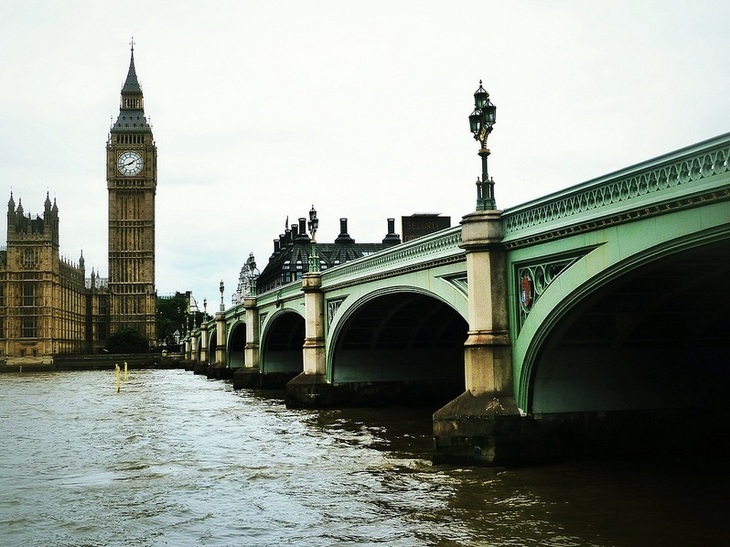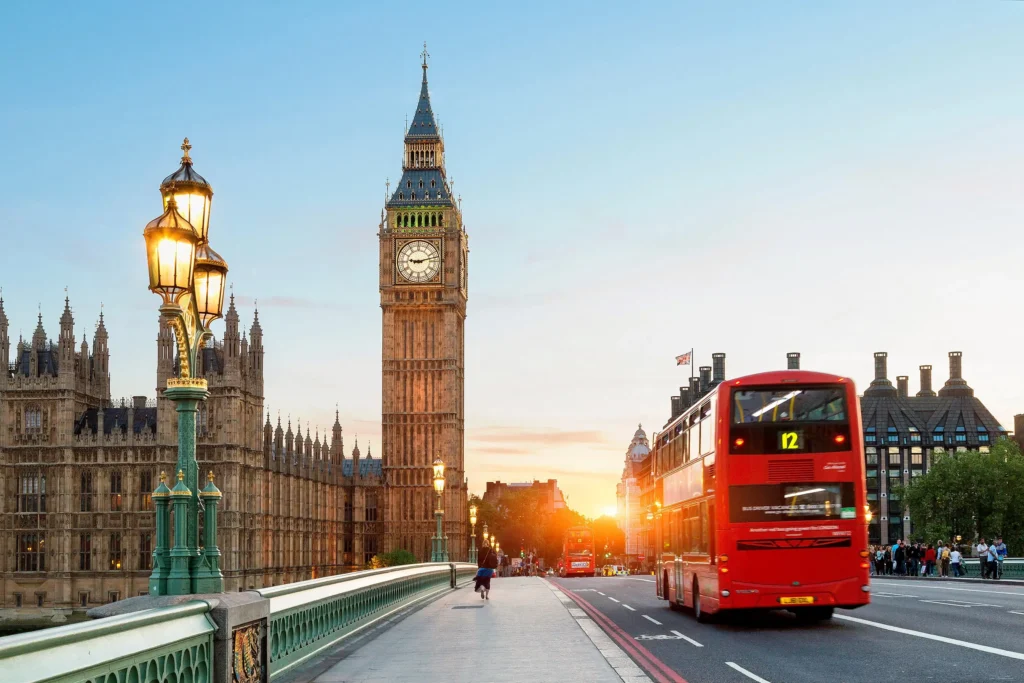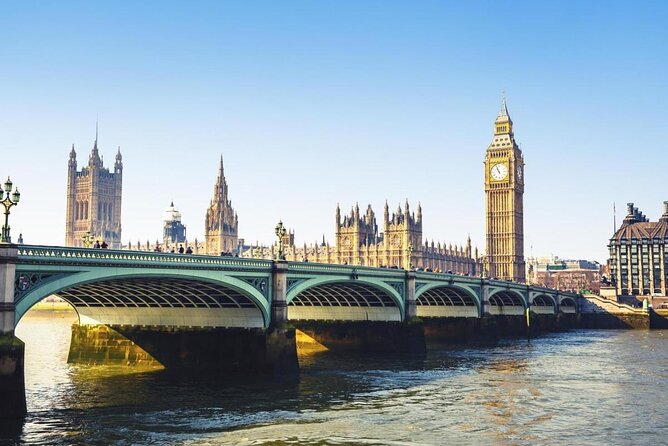Westminster Bridge, spanning the River Thames in London, connects the districts of Westminster and Lambeth. Painted predominantly green, it mirrors the leather seats of the House of Commons, contrasting with the red hue of Lambeth Bridge, symbolizing the House of Lords.
In 2005–2007, the bridge underwent a comprehensive refurbishment, including the replacement of iron fascias and a fresh coat of paint.
Serving as a vital link between iconic landmarks such as the Palace of Westminster, County Hall, and the London Eye, Westminster Bridge holds historical significance. It is recognized as a Grade II* listed structure, highlighting its importance in London’s architectural heritage.
So, its position as the finish line for the early editions of the London Marathon adds to its cultural prominence in the cityscape.
Why Is Westminster Bridge Historically Significant?

Westminster Bridge stands as an iconic symbol of London’s rich history and enduring resilience. Its origins can be traced back to the 17th century when the need for an additional crossing over the River Thames became apparent.
Proposed in 1664, the idea faced strong opposition from the Corporation of London and the river’s watermen. They were worried the bridge would disrupt their jobs and the flow of river traffic.
Despite initial setbacks, the pressing need to alleviate congestion at London Bridge persisted. The growing population and expanding trade in the capital made finding a solution to the bottleneck imperative.
Moreover, it wasn’t until 1736 that Westminster Bridge received parliamentary approval for construction, marking a significant milestone in the city’s infrastructure development.
Further, the ambitious project was financed through a combination of private capital, public lotteries, and governmental grants. The renowned Swiss engineer Charles Labelye was tasked with overseeing the construction. The project commenced in 1739 and spanned over a decade until its completion in 1750.
In addition, this period saw a flurry of activity along the banks of the Thames as laborers toiled to erect the majestic structure. This structure would forever alter the city’s landscape, marking a significant transformation in its architectural heritage.
Upon its opening on 18 November 1750, Westminster Bridge instantly became a focal point of London’s transportation network. Its strategic location facilitated the movement of goods, people, and ideas between the bustling West End and the burgeoning districts of South London. Further, the bridge not only provided a vital link across the river but also catalyzed urban development on both sides of its imposing arches.
Additionally, the success of Westminster Bridge paved the way for a series of subsequent crossings over the Thames, including Blackfriars, Kew, Battersea, and Richmond bridges. These architectural marvels further enhanced London’s connectivity and spurred economic growth, transforming the city into a thriving metropolis.
However, the passage of time took its toll on Westminster Bridge, and by the mid-19th century, it faced structural challenges and mounting maintenance costs. In response, the decision was made to replace the aging structure with a new, more resilient bridge.
Designed by the esteemed engineer Thomas Page and adorned with Gothic detailing by Charles Barry. The new Westminster Bridge emerged as a testament to Victorian engineering prowess. Its architectural grandeur is celebrated for its intricate design and structural innovation.
Throughout its storied history, Westminster Bridge has borne witness to both triumph and tragedy. On 22 March 2017, it became the scene of a horrific terrorist attack. This attack claimed the lives of innocent pedestrians and a brave police officer. The loss of these lives, along with the injuries sustained by over 50 others, cast a somber shadow over the bridge and the surrounding area.
The shocking event sent shockwaves through the city, yet, in the face of adversity, Londoners rallied together in solidarity and resilience, reaffirming their unwavering spirit.
Today, Westminster Bridge stands as more than just a crossing over the Thames. It is a symbol of London’s resilience, unity, and unwavering resolve in the face of adversity.
As millions of commuters and tourists traverse its historic arches each year, they are reminded of the city’s enduring legacy. The indomitable spirit that defines it is evident in every aspect of its architecture and culture.
Tragedy Strikes Body Found Near Westminster Bridge

On March 29, a distressing incident unfolded along the River Thames, near Westminster Bridge, culminating in the recovery of a man’s body from the water. The somber discovery followed a report received by authorities at approximately 2:25 pm, alerting them to a body spotted floating near Waterloo Bridge.
Upon responding to the scene, police swiftly located and retrieved the man’s body, which had drifted to the vicinity of Westminster Bridge. The Metropolitan Police, now tasked with the solemn duty of identifying the deceased individual, are diligently working to notify his next of kin.
This unfortunate event occurred against the backdrop of another tragedy that transpired a day earlier. In Battersea, a man lost his life after his vehicle plunged into the River Thames. Responding to reports of the submerged car at Vicarage Walk, authorities recovered the vehicle, finding the driver deceased inside.
Moreover, as investigations into both incidents unfold, authorities are committed to unraveling the circumstances surrounding these tragedies. The Metropolitan Police assures thorough inquiries will be conducted to shed light on the events leading to these unfortunate outcomes. Their goal is to provide closure to the families affected by this tragedy.
FAQ’s
Why is Westminster Bridge so famous?
Westminster Bridge is famous for its architectural beauty and iconic views of London, including landmarks like the London Eye, Big Ben, and the Houses of Parliament. It has also been depicted in famous artworks and literature, such as Wordsworth’s poem “Upon Westminster Bridge.”
In which city is Westminster Bridge?
Westminster Bridge is located in the city of London, connecting the North Bank of the River Thames to the South Bank. It offers panoramic views of the river and iconic landmarks such as the London Eye, Big Ben, and the Houses of Parliament.
Which famous river is mentioned in the poem “Upon Westminster Bridge”?
The River Thames is the famous river mentioned in the poem “Upon Westminster Bridge” by William Wordsworth. The poem describes the serene beauty of London as seen from Westminster Bridge in the early morning.
What bridge is near the London Parliament?
Westminster Bridge is the bridge near the Houses of Parliament in London, England. It offers picturesque views of the Parliament building and the iconic clock tower known as Big Ben.
What is Westminster famous for?
Westminster Abbey is perhaps the most famous landmark in Westminster, known for its royal weddings, coronations, and burials. It has a rich history dating back nearly 1000 years and remains a popular tourist attraction in London.
What is unique about Westminster Abbey?
Westminster Abbey is unique because it is “royal peculiar,” meaning it is under the jurisdiction of the British monarch rather than the Church of England. It has also been the final resting place for numerous royals, including kings, queens, and other notable figures.
Why is Westminster considered a city?
Westminster became a city in 1965 when it was created from the amalgamation of three metropolitan boroughs: St Marylebone, Paddington, and the Metropolitan Borough of Westminster. It is an inner borough of London, England, located in the heart of the city’s West End.
Which part of the UK is Westminster located in?
Westminster is located in the city of London, England. It is an inner borough situated on the north bank of the River Thames, adjacent to Kensington and Chelsea to the west and the City of London to the east.
How many bridges are there in London?
There are 35 bridges crossing over the River Thames in London. These bridges serve as important transportation links and iconic landmarks, contributing to the city’s picturesque skyline and historical significance.
What type of poem is “Upon Westminster Bridge”?
“Upon Westminster Bridge” is a Petrarchan sonnet, a poetic form popularized by the Italian Renaissance poet Petrarch. It consists of fourteen lines divided into an octave and a sestet, typically with a rhyming scheme of ABBAABBA for the octave and CDCDCD or CDECDE for the sestet.
What is the nickname of Westminster Bridge?
Westminster Bridge is nicknamed the “Bridge of Fools” due to delays in its construction, which lasted longer than anticipated. Despite its nickname, the bridge remains a beloved and iconic landmark in London.
Who designed Westminster Bridge?
Westminster Bridge was designed by Thomas Page and opened on May 24, 1862. It is a seven-arch, cast-iron bridge with Gothic detailing by architect Charles Barry, who also designed the nearby Palace of Westminster.
What color is Westminster Bridge?
Westminster Bridge is painted verdant green as an homage to the leather seats in the House of Commons, which is the closest part of the Palace of Westminster to the bridge.
Final Words
Westminster Bridge is a vital link spanning the River Thames in London, connecting Westminster and Lambeth. Its iconic green color reflects the nearby House of Commons, while its refurbishment in 2005–2007 ensured its continued functionality and aesthetic appeal.
Moreover, serving as a crucial pathway between prominent landmarks such as the Palace of Westminster and the London Eye, the bridge holds historical significance. It remains a cherished part of the cityscape, reflecting London’s rich architectural heritage.
With its Grade II* listed status and role as a finish line for the London Marathon, it stands as a symbol of London’s rich heritage. Additionally, it represents the city’s enduring connectivity and serves as a testament to its historical and cultural significance.



